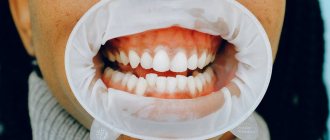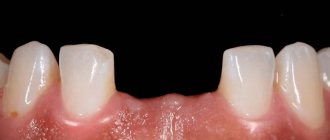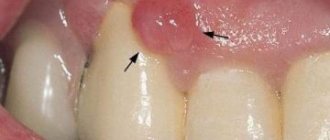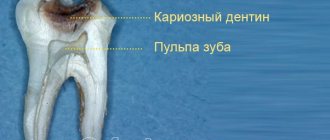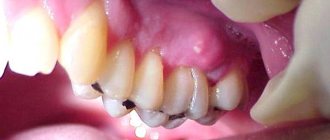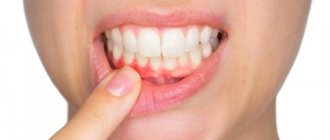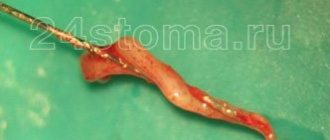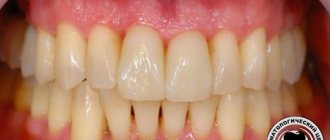Causes of dental hyperesthesia
As a rule, all forms of hypersensitivity of teeth occur during improper dental treatment or violation of oral care rules, namely:
- violation of the technique of filling dental holes;
- unprofessional treatment of caries;
- traumatic damage to the tooth surface;
- the occurrence of splits, chips or cracks in dental tissue;
- broken tooth crown;
- mechanical injuries of the short frenulum of the lower and upper lip and tongue;
- wearing low-quality dentures or crowns;
- violation of the integrity of the enamel;
- improper use of dental floss;
- brushing your teeth with a stiff toothbrush;
- violation of the rules for polishing teeth;
- Improper teeth whitening procedure.
It is frequent bleaching and irregular treatment of caries that lead to complications. Periodontal disease can also increase tooth sensitivity. This disease is accompanied by exposure of the cervical area of the tooth, which leads to gum recession.
Hypertension may appear or be aggravated by initial caries. In addition to a pain reaction due to external factors, dental hypertension can be associated with internal problems of the body. Such problems include diseases of the gastrointestinal tract, metabolic disorders, neuroses and age-related hormonal changes.
Method for sealing dentinal canals
This method uses a dentin sealant that has been developed to eliminate the harmful effects of filling materials on dentin. It was soon discovered that the sealant could be used to treat exposed dentin, thereby eliminating sensitivity.
The polymer resins contained in the sealant contribute to this effect. Penetrating into the mouths of the canals, these resins polymerize and sealing occurs.
Indications for this procedure are:
- gum recession and enamel wear;
- sensitivity of the tooth stump, which appeared after its preparation for installation of a crown;
- abnormal abrasion of tooth enamel;
- dental defects that cannot be corrected with filling material.
The treatment procedure begins with the preparation of dental units. Dental plaque is removed from them, followed by drying and isolation from saliva. After applying the sealant, you need to wait some time for chemical polymerization to occur. To speed up this process, some specialists use a special lamp designed for light-curing composites.
Clinical manifestations of dental hyperesthesia
Typically, patients acutely feel increased sensitivity of teeth during or after eating sweet, sour, salty and spicy foods. Also, pain in patients with hyperesthesia can be caused by exposure of the teeth to low air temperature, hot or cold food, as well as touching the teeth. In this case, the nature of the pain can be either minor and manifest only as discomfort, or intense with significant pain. This is due to the fact that dental hyperesthesia has three stages of manifestation. At the first stage, tooth tissues react only to a temperature stimulus, and at the second stage, the intensity of pain increases both from temperature changes and from chemical stimuli. The third stage is caused by an acute, painful reaction to any of the listed stimuli.
In addition to the appearance of pain, hyperesthesia is accompanied by symptoms such as:
- increased salivation;
- facial swelling;
- pain when talking and eating.
During this period, the patient experiences difficulties in caring for the oral cavity. In some cases, due to severe pain, it is simply impossible to carry out hygiene procedures. This leads to the appearance of plaque, and later caries, which is aggravated by inflammatory and destructive changes in periodontal tissue. In the future, these factors can lead to gum recession or hyperplasia, which further intensify the symptoms of dental hyperesthesia. Therefore, it is very important to diagnose and begin treatment for dental hypersensitivity in a timely manner in order to prevent the occurrence of other oral diseases.
Symptoms of pathology
The body may react to dental tissue irritants with severe pain or discomfort.
At the beginning of the development of pathology, the reaction of the teeth is expressed only to hot and cold foods. Unpleasant sensations can pass quickly - immediately after exposure to the irritant or within a few minutes after it.
The next stage is that in addition to the reaction to temperature, the reaction to taste is added.
In case of deep pathology, in addition to the listed reactions:
- Pain appears on tactile contact;
- You feel discomfort when brushing your teeth;
- Serious dental problems arise.
Methods for diagnosing dental hyperesthesia
If the patient experiences pain in the dental tissues, the doctor conducts a visual and instrumental examination of the patient’s oral cavity. The dentist examines the teeth for cracks, chipped enamel and other changes. In addition to the examination, the doctor asks the patient about the frequency of pain in order to find out the degree of sensitivity of tooth enamel to various irritants. This allows the specialist to differentiate dental hyperesthesia from acute pulpitis, since the similarity lies in the presence of acute pain and difficulties in identifying the diseased tooth. If hypertension is caused by damage, then before starting treatment, the doctor makes a correction that will relieve the patient of painful symptoms. The specialist can also carry out treatment of carious lesions and professional oral hygiene. The treatment method is prescribed depending on the stage of severity of hyperesthesia.
How is hyperesthesia diagnosed?
Only a dentist can diagnose hyperesthesia. Usually, an instrumental examination of the patient’s oral cavity is enough for this. The teeth are examined for chips, cracks and other changes in the surface layer. A conversation is held with the patient and information is collected about the duration of the pain syndrome, as well as the types of irritants. As an additional diagnosis, a specialist can conduct a differential research method. The main task facing the doctor is not to confuse the symptoms of acute pulpitis with hypersensitivity.
Methods for treating dental hyperesthesia
Treatment of dental hyperesthesia is a rather complex and lengthy process. The treatment method depends on the cause of hypersensitivity and the degree of development of hyperesthesia. As a rule, therapeutic methods are used during treatment; surgical intervention is less often used.
For dental hyperesthesia, treatment consists of influencing the development mechanism itself. Therefore, in order to eliminate the flow of dental fluid and restore intracanal pressure, it is necessary to block the dentinal tubules. To do this, the patient is prescribed drugs that promote the binding of hard tissue proteins with the active substance, which settle in the tubule, thereby strengthening it.
Also, one of the methods for eliminating hyperesthesia is fluoridation of teeth. This procedure is aimed at eliminating tooth sensitivity to irritants by applying cotton swabs made of fluoride and calcium salts to the diseased teeth. At this moment, fluorides block the dentinal tubules, and fluoride ions interact with calcium ions and fill the dentinal tubules with the insoluble compound calcium fluoride. As a result, the speed of fluid flow in the dentinal tubule decreases, and the reaction to external stimuli becomes less pronounced.
If the disease occurs due to a carious process, then the patient undergoes tooth preparation, cleaning of the cavity from affected tissue and installation of a filling.
If increased sensitivity appears after whitening or brushing teeth, then in this case, electrophoresis and a solution of calcium glycerophosphate are used for dental hypertension (treatment). The patient can also have the enamel coated with sodium and calcium fluorides.
When the gums recede, periodontal inflammation or opening of the cervical zone, the patient undergoes surgical treatment. During the operation, the dentist covers the neck of the tooth and lifts the gum.
If a patient experiences increased tooth wear, he undergoes orthodontic treatment, during which the bite is corrected.
To reduce the excitability of nerve endings in the dentin tubules in a patient with hyperesthesia, potassium salts are used so that the diffusion process of potassium ions into the canals occurs. This treatment method consists of creating a protective shell in the dentinal tubules and blocking the transmission of nerve impulses.
Also, to treat hyperesthesia, the patient can use traditional medicine. Such treatment involves the use of only herbal medicines. According to the doctor’s recommendations, the patient can use folk remedies not only for treatment, but also for the prevention of a number of dental diseases.
Causes of hypersensitivity
All reasons can be divided into three types.
- System. Caused by nervous disorders and general diseases. The most common.
- Local. Occurs in a third of cases. May be caused by:
- Caries;
- Thinning of the enamel;
- Wedge-shaped defect;
- Exposing the neck of the tooth;
- Damage to dentin;
- Injuries with tooth destruction, cracking and damage to the enamel.
- Iatrogenic causes, when enamel damage occurs as a result of unprofessional treatment. In particular, when:
- Treatment of caries;
- Prosthetics;
- Chemical etching;
- Incorrect whitening, when the enamel becomes white but sensitive;
- During aggressive hygiene procedures.
The pathology has gender and age characteristics: women and middle-aged people are most prone to hypertension.
Oral care for dental hyperesthesia
Prevention of dental hyperesthesia includes a number of therapeutic measures that are aimed at preventing increased sensitivity. There are special oral care products that, when used regularly, help patients eliminate discomfort and prevent the development of hyperesthesia with pronounced pain. These are toothpastes, gels, medicinal decoctions; The duration of their use is determined as prescribed by a specialist according to the patient’s feelings. If hyperesthesia is caused by sensitivity to temperature stimuli, then the patient is recommended to take products that seal the dentinal canals and prevent pain.
In addition, to prevent dental hyperesthesia, the patient must adhere to certain rules, namely:
- observe the rules of oral hygiene. Carry out systematic brushing of teeth using toothpastes that contain:
- nitrates;
- potassium chlorides;
- sodium fluoride;
- strontium chlorides;
- calcium;
- quotes;
- In order to increase effectiveness and prevent addiction, experts recommend periodically changing toothpastes. In this regard, the patient should use toothpastes with a low level of abrasiveness or gel toothpastes;
- do not use whitening toothpastes, as they contain chemical elements that cause damage to tooth enamel and wash away calcium from the teeth;
- brush your teeth correctly. It is recommended to use a small amount of toothpaste and brush your teeth without unnecessary effort. After eating sour or sweet foods, you need to rinse your mouth well;
- Use a medium-hard or soft toothbrush that will not injure your gums and teeth. It is important to choose toothbrushes that have rounded or smoothed ends of the bristles and an even cut shape;
- use additional care items (such as dental floss or toothpick);
- use elixirs to rinse sensitive teeth;
- eat right, or rather do not eat foods that contain calcium and phosphorus;
- reduce the consumption of sour and sweet foods;
- rinse the mouth with medicinal herbal decoctions;
- visit the dentist regularly.
Dental hyperesthesia is a serious disease that can occur at any age. The prognosis of treatment depends on the cause of the disease and its stage. The most important thing in the early stages of the disease is to see a dentist and follow the rules of dental care.
